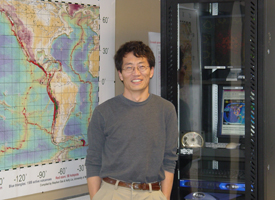Current
Publications
Tools
About Us
Office of Public Relations
105A CSF
1870 Miner
Circle
Rolla, MO65409-0220
(573) 341-4328
(573) 341-6157 (fax)
news@umr.edu
Over the past several decades, the United States Government established the Global Seismographic Network to monitor nuclear explosions worldwide. That network has also proven to be a crucial source of information for geologists and geophysicists like Drs. Stephen Gao and Kelly Liu, who are trying to unlock secrets about the earth’s crust.
In addition to recording nuclear tests and other large explosions, the 250 seismographic stations situated around the globe capture information about earthquake events, volcanic eruptions and other outbursts of energy. Gao and Liu, associate professors of geophysics at the University of Missouri-Rolla, receive the data in real time through a UMR computer capable of handling 6,000 gigabytes of information.
 |
| Dr. Stephen Gao utilizes computing to monitor the world's seismic activity in real time. He hopes to use the data to find out more information about the earth's crust. |
By studying how seismic waves propagate through the earth, Gao and Liu hope to answer some old questions about the nature of the earth’s crust. Most geoscientists believe 85 percent of the crust was formed in the earth’s first billion years. Others believe the crust has formed gradually over geologic time.
“We study the thickness, density, and composition of the crust below the 250 stations,” Gao says. “The larger the seismic event, the more data we get. By analyzing the seismic waves using sophisticated computer programs, we can peek into the earth’s interior and reveal its secrets.”
The early earth was a very volatile place and its interior was hotter, according to most geoscientists. The age of the crust observable today varies wildly from place to place due to plate tectonics and the constant activity below the earth’s surface. While the crust in Missouri might be 1.6 billion years old, it could be 3 billion years old in Minnesota or just half-a-billion years old in Japan. Gao and Liu are looking to see if there is a correlation between the age of the crust and changes in its composition and properties. Such changes, if revealed, could suggest that the processes that formed the crust during the early history of the earth were different from the processes we see today.
On average, the earth’s crust is about 22 miles thick. The crust floats, for lack of a better word, on top of the mantle. Over time, the crust moves and continental plates collide, creating areas of high seismic and volcanic activity.
“The modern view is that crust is generated by the subduction of plates into the earth’s mantle,” says Gao. “But the crust that is formed in subduction zones today could be located somewhere else in the world tomorrow, in geological terms.”
In subduction zones, one plate burrows under another into the hot mantle. The melting of rocks in the deep interior of the earth creates volcanoes above those zones, and the crust of the top plate is pushed up to form large mountain ranges like the Andes in South America. Plate subduction is also responsible for causing powerful earthquakes when the plates move.
What geoscientists like Gao and Liu are trying to find out is whether or not the processes of crust generation have stayed consistent throughout the planet’s volatile history.
The UMR research is supported through a grant of approximately $190,000 from the National Science Foundation.


 print page
print page search
search University of Missouri-Rolla · 1870 Miner Circle · Rolla, Missouri
65409
University of Missouri-Rolla · 1870 Miner Circle · Rolla, Missouri
65409